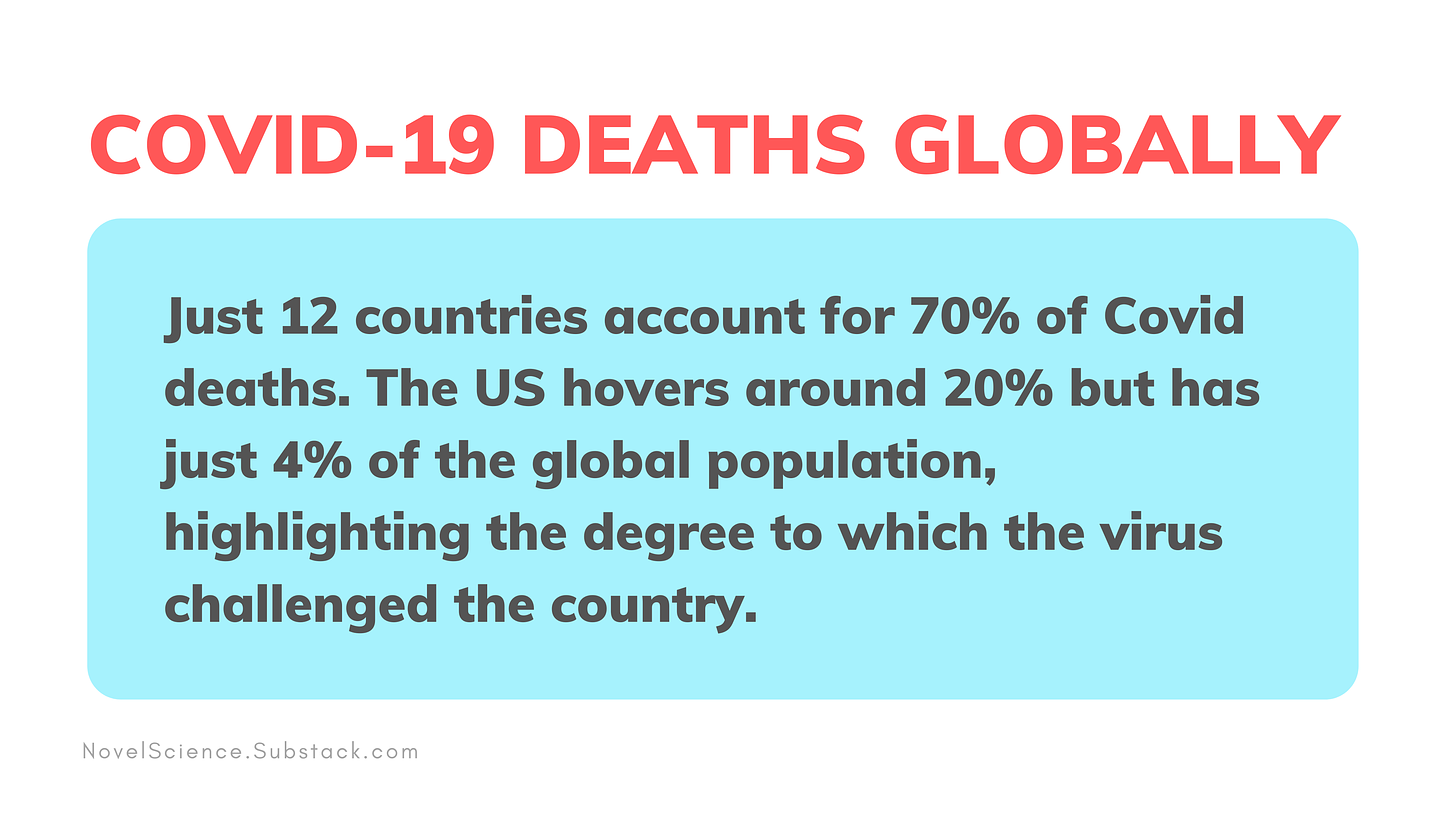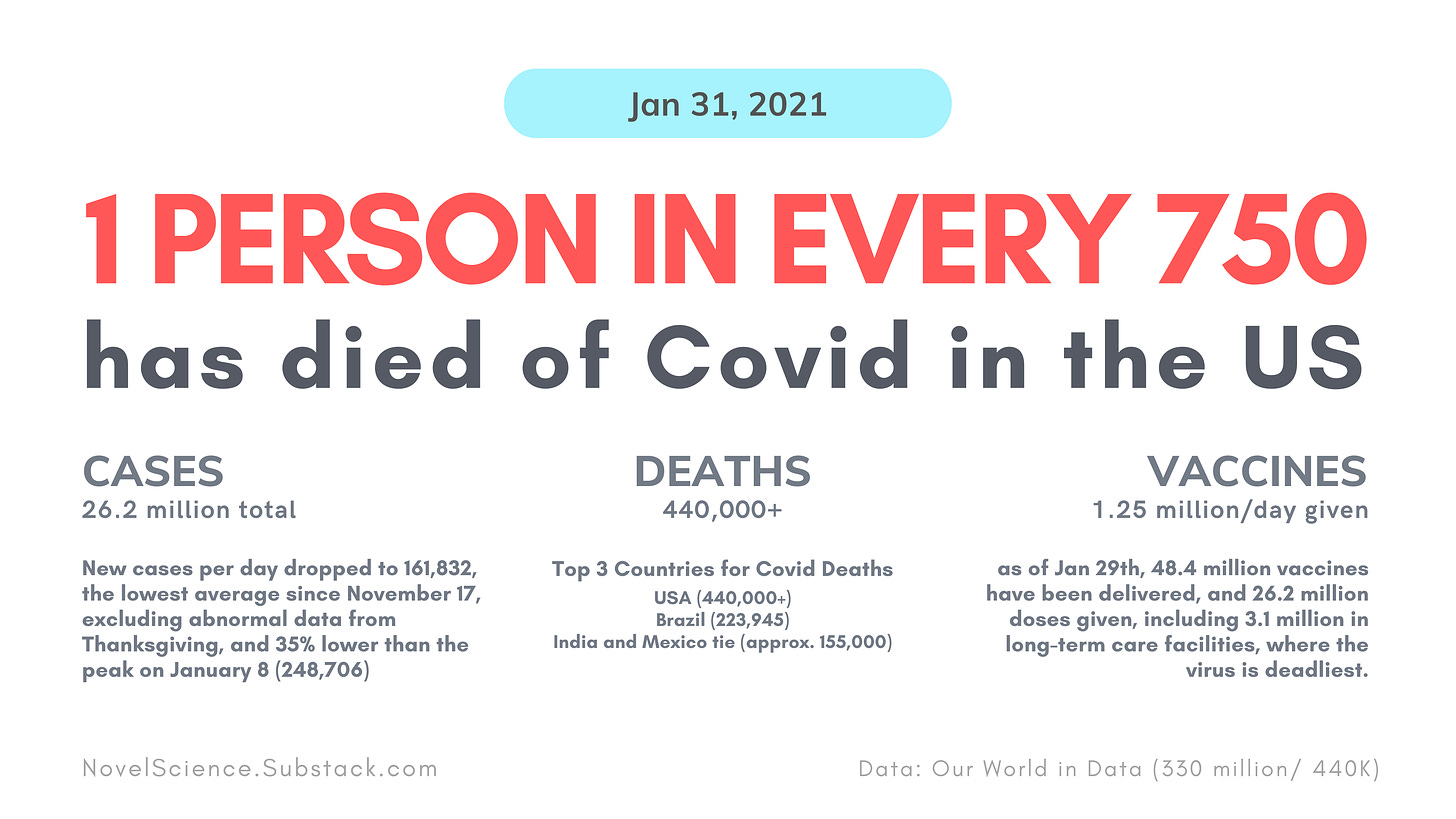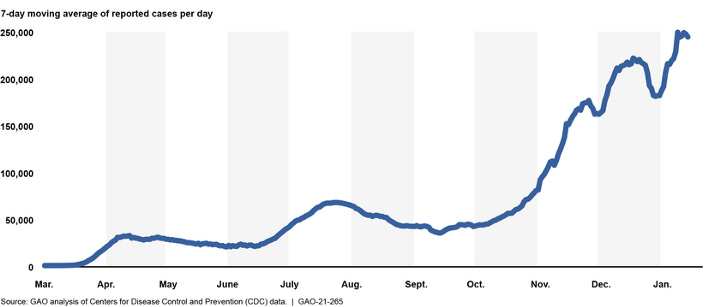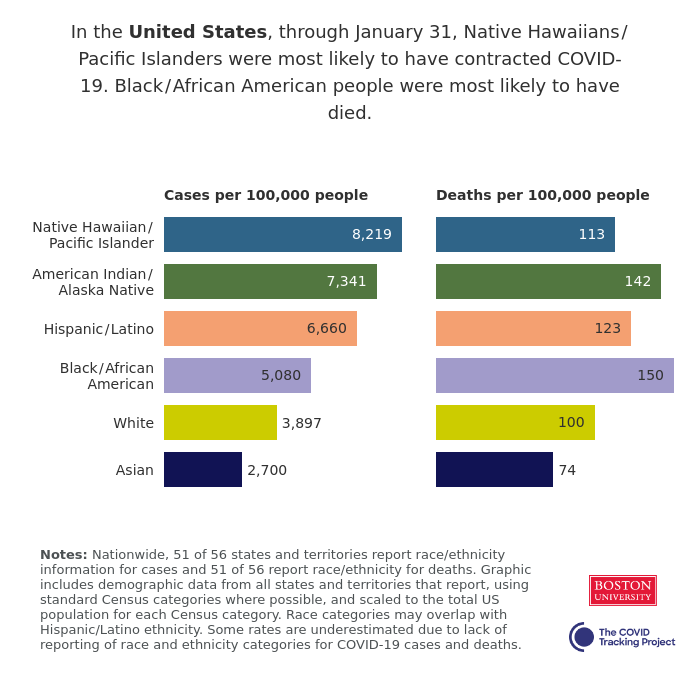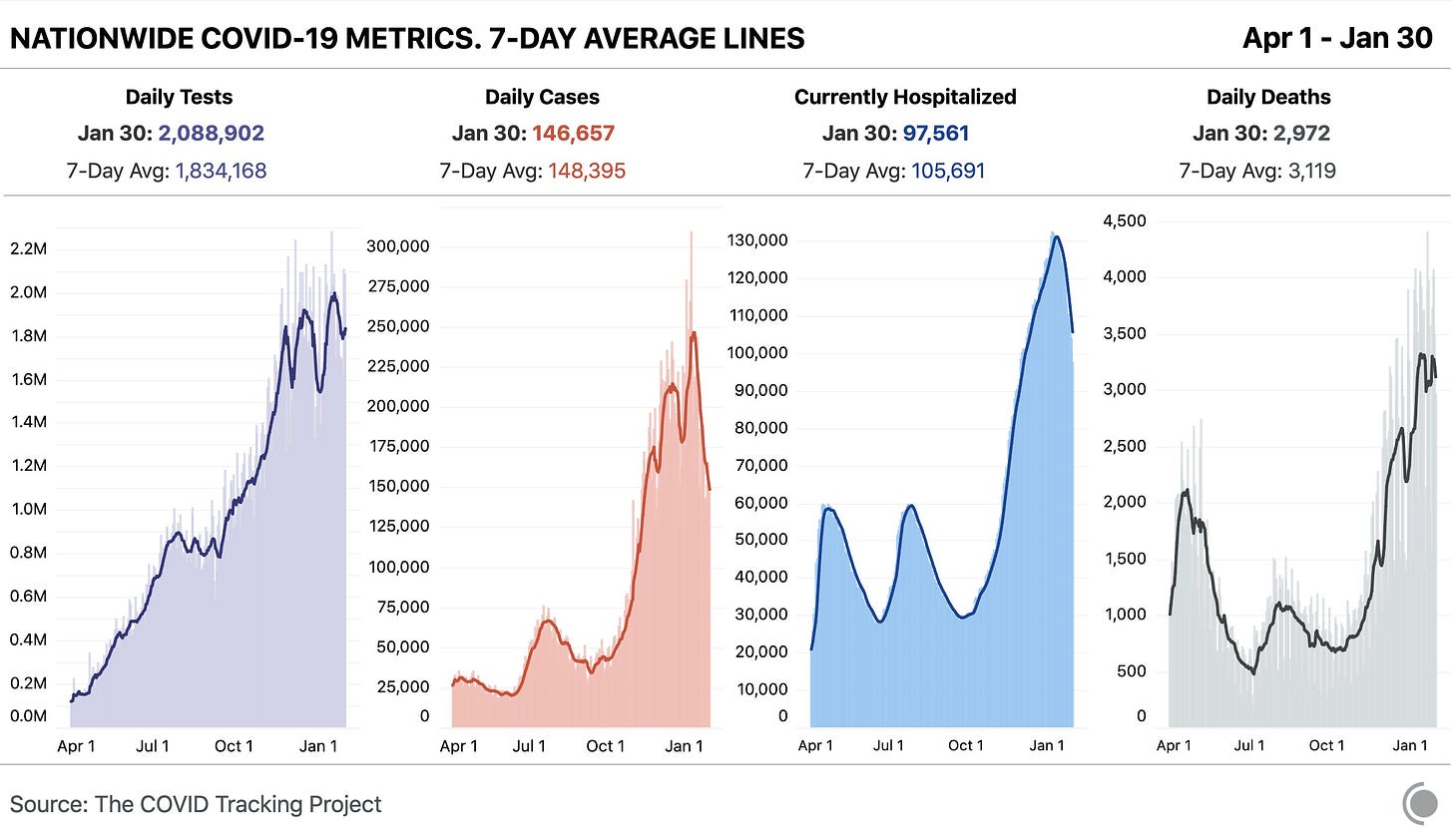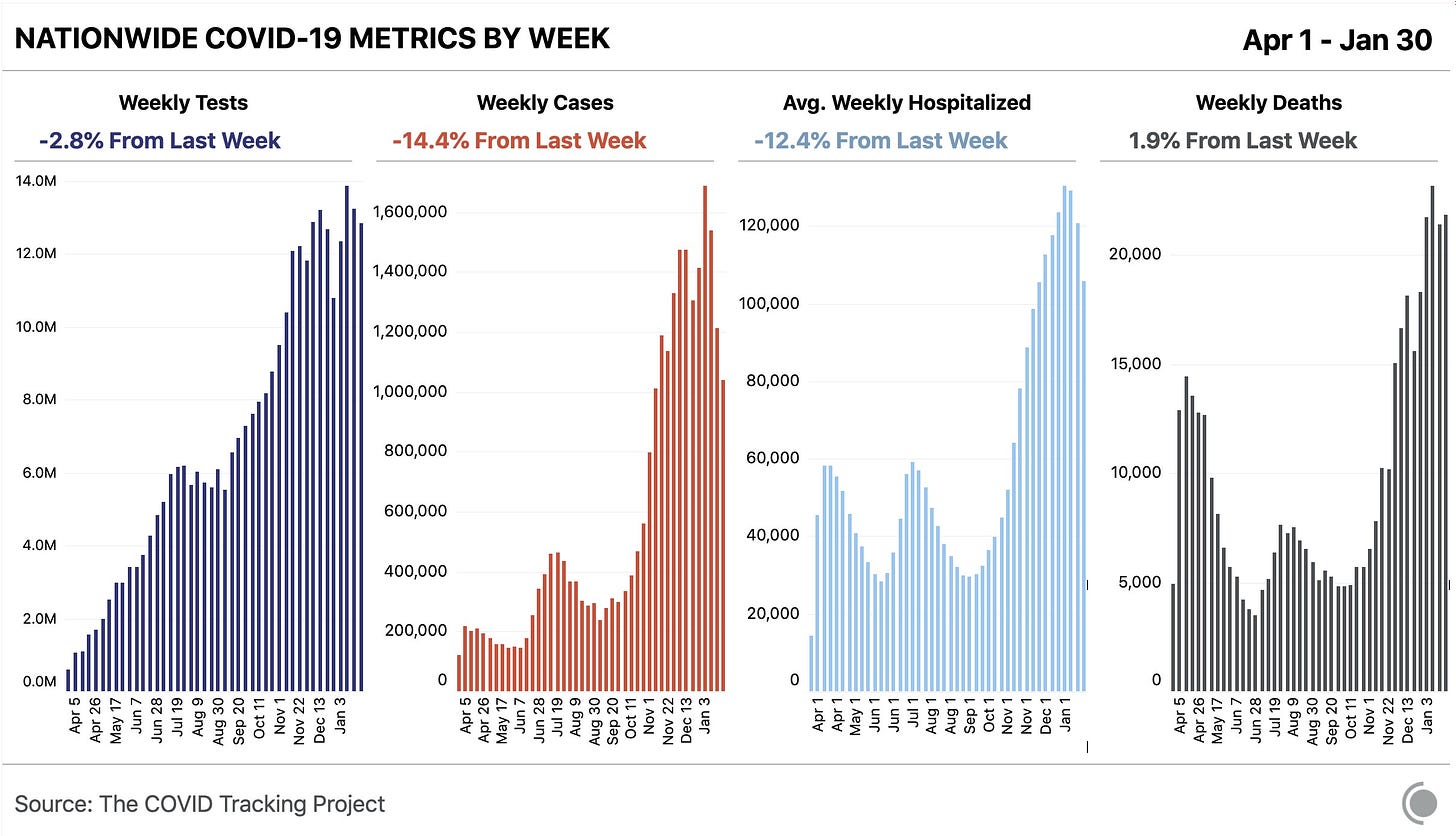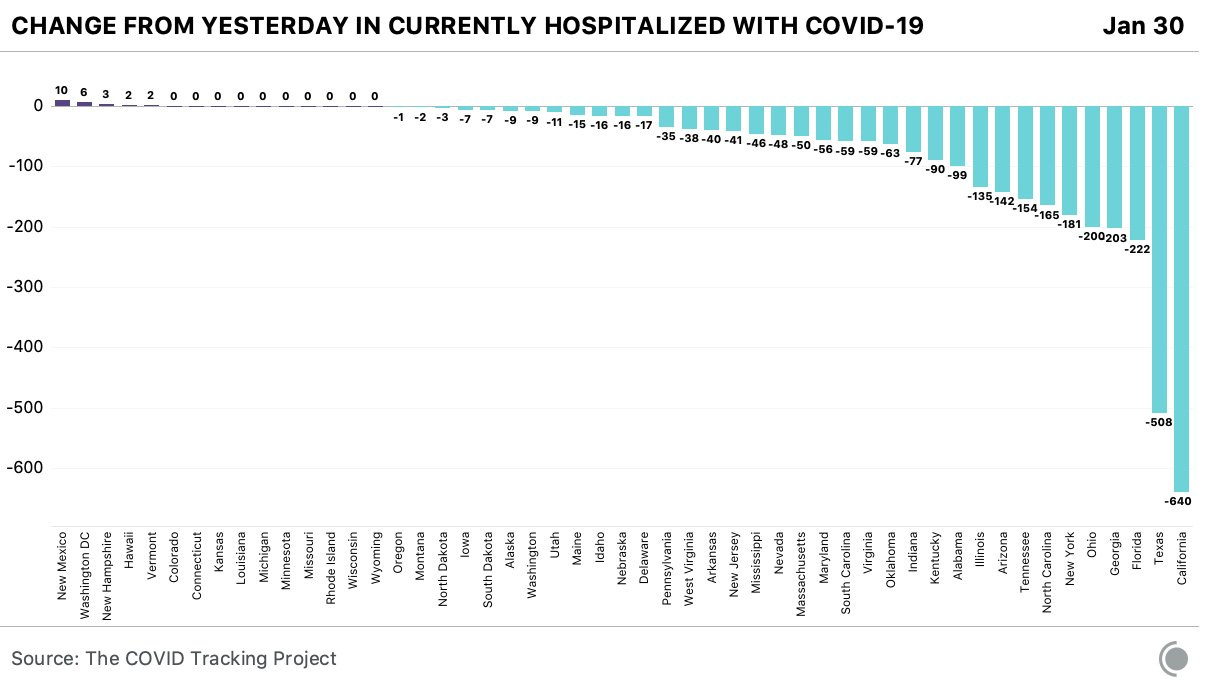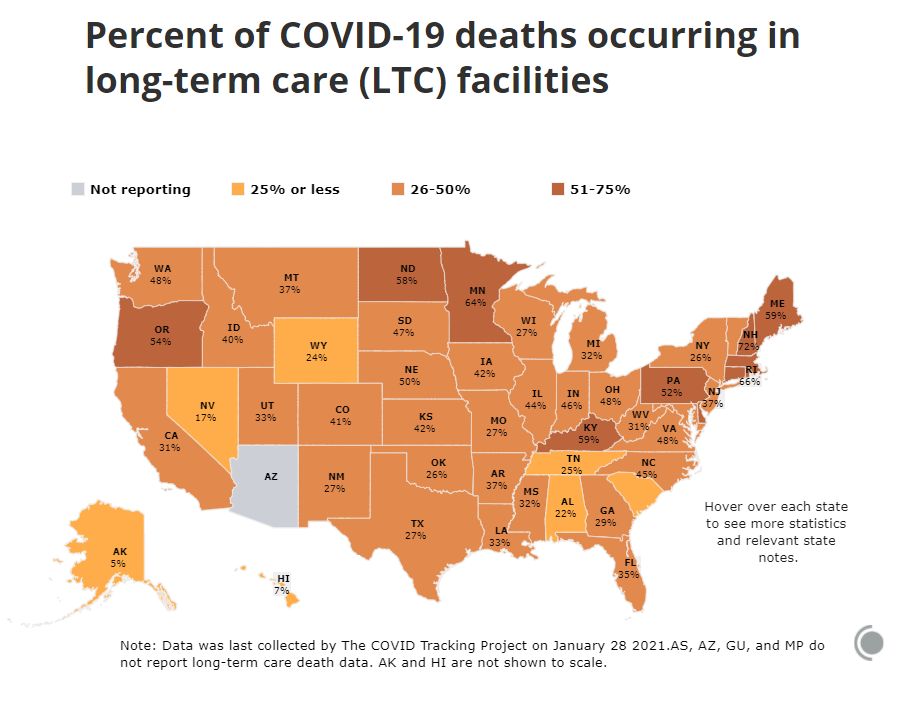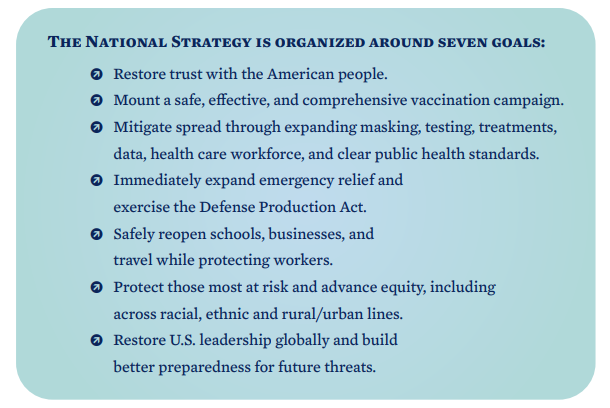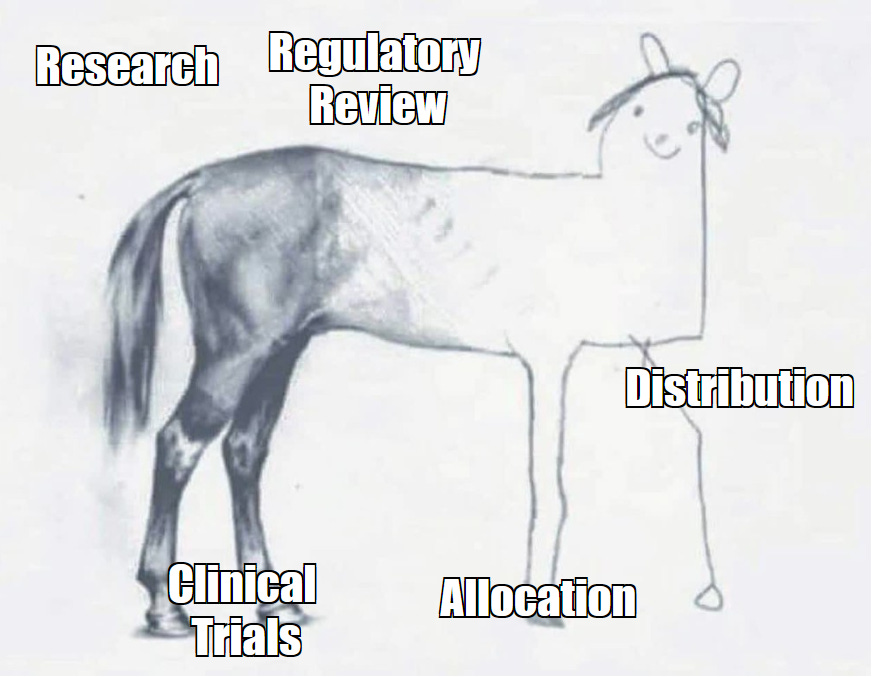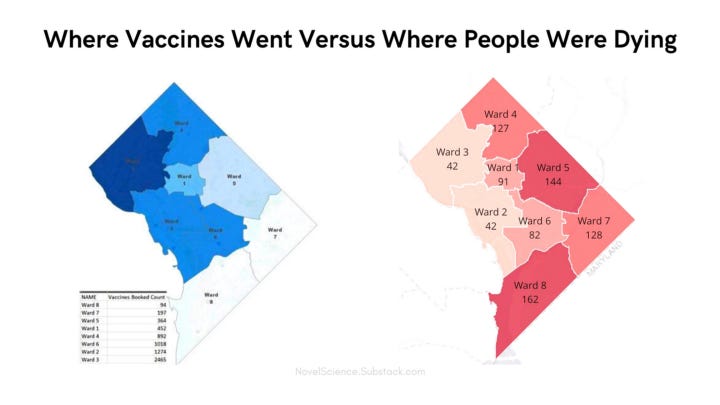Covid Update, Vaccines, Transition to Biden, and the National Strategy for Pandemic Response
Jan 31, 2021, a Novel Science newsletter
The audio version:
Covid-19 Situation Report
The big question: When will we know if Biden had the impact he promised? When will we see this turning around?
Answer: We may see some positive improvements in the first 100 days, but much of the death we’re seeing now was set on an unstoppable trajectory in November and December.
That said, expect improvements by March and a full effect by summer. If this administration fails to live up to its promise, you can be sure we will report on that.
What’s at stake?
Researchers using a novel method of forecasting that leverages both mathematics and human judgment finds that if 50% of the U.S. starts the vaccination process by March 1, 2021, then the death count prediction for Dec. 31, 2021, is 520,000. In contrast, if less than 50% have started the vaccination process, then the prediction shot up to 645,000 deaths by Dec 31st.
This is just a model, so it's not meant to tell the future, only to give us a rough idea so we can plan accordingly.
Context: In 1918, the US lost about 675,000 people to the pandemic influenza.
Worldwide
Worldometer reports 103,478,294 cases and 2,236,267 million deaths as of 5:30 pm EST on January 31, 2021. Globally the number of Covid cases passed 100 million on January 28. Our World in Data reports that 95 million vaccine doses have been administered globally. That’s an increase of well over 50% compared to last week.
1 case to 20 million: 220 days
20 to 40 million cases: 68 days
40 to 60 million cases: 38 days
60 to 80 million cases: 32 days
80 to 100 million cases: 32 days
Top Three Countries for Covid Deaths
United States (440,000+ deaths)
Brazil (223,945)
India and Mexico alternate, so they are tied(154,274 and 158,074, respectively)
In total, 12 countries are reporting more than 50,000 deaths, including 6 in Europe, 4 in the Americas, 1 in Asia, and 1 in the Eastern Mediterranean region. Africa is doing notably well in this pandemic and that may be because they are expert contact tracers, even in regions without electronics and mailing addresses.
No, it's not because of hydroxychloroquine despite what various internet pundits speculate. The drug isn't in use as an antimalarial in many of the areas doing well, and if you write the editors they will probably cry. It's not chloroquine.
Simply, for a battle with a virus, many Asian and African countries are better prepared and their citizens don’t have to be convinced about the seriousness. That was a massive advantaged in this pandemic. Countries that had a mask-wearing culture, where masks are worn by anyone who feels sick, avoided a struggle to get people to adopt mask-wearing.
United States
Cases per day were down below 165,000 cases on Jan 29th, the lowest average since November 17, excluding abnormal data from Thanksgiving. That’s 35% lower than the peak on January 8, when it was nearly 250,000 cases per day.
We can say with relative certainty that the incidence has truly begun to decrease, and it likely peaked around mid-January — although difficult to determine exactly when due to fluctuations in reporting around the winter holidays.
Daily Covid deaths have hovered around 3100 deaths since the beginning of January.
If it did peak in mid-January we can expect to observe an associated decrease in daily mortality starting sometime in the next several weeks.
Case and Death Data by Race and Ethnicity
An update from the COVID Tracking Project at The Atlantic
a project dear to us at Novel Science.
In the weekly view, cases are down 14% and current hospitalizations are down 12%. Tests are down about 3%, and reported deaths rose about 2%.
The number of people currently hospitalized with COVID-19 in the US is now below 100k for the first time since December 1. Almost all US states are seeing hospitalizations decline or flatten, and CA, FL, and TX all posted big drops today.
For a deeper analysis: Outbreaks Ease Across the US, but Our Numbers Are Still Very High: This Week in COVID-19 Data, Jan 28
For more on long-term care: The Long-Term Care COVID Tracker
On Emerging Variants
The recently discovered SARS-CoV-2 variants of concern continue to spread globally. The B.1.351 variant was identified in South Carolina this week, which is the first time the variant has been reported in the US. The people identified had “no known connection” nor did they have a recent travel history.
That says this is already spreading in communities in the US. At least 30 countries have reported the B.1.351 variant, which nabbed headlines because existing Covid vaccines may not offer as much protection against it. The US failed to launch any large-scale genomic sequencing. Experts have called for a national program to track this for the duration of the Covid-19 pandemic.
Sequencing would allow us to detect where these worrisome variants are spreading, which would allow us to use targeted measures of containment where it’s needed instead of a broad, unnecessarily damaging national measure. Unfortunately, our monitoring of variants lacks the type of sophisticated strategy one would expect from a global superpower like the US.
We’re now sequencing around 3,000 specimens each week, out of 1.4 million positive tests. These efforts are led by “a patchwork of academic, state, and commercial laboratories” rather than a formal, centralized, and coordinated national system. Every time the virus duplicated itself, we grant it a roll of the evolutionary dice.
While the virus isn’t likely to completely outmaneuver the vaccine, it could increase disease severity or mortality, start spreading more easily or infect new animal species. There are no guarantees, and the first mutations that happened months ago should have been taken as a warning to us. It wasn’t.
The US CDC reports, as of Jan 29th, 48.4 million vaccines have been delivered, and 26.2 million doses given, including 3.1 million in long-term care facilities where the disease is most deadly.
About half of the vaccines delivered have been given. We don’t have a vaccine shortage until states are out of them. Currently, we’re increasing both production and the speed at which people get them.
Warp Speed failed to plan for administering the vaccines, focusing mostly on the development, but Moderna had developed its mRNA vaccine by the end of Jan 2020.
Overlooking distribution in the Summer, Fall, and Winter of 2020 left the US ill-prepared for a record-making feat of vaccine delivery.
At least, 21.7 million people have had one dose of a coronavirus vaccine. 4.3 million have had two doses.
The US is now averaging 1.25 million doses administered per day, with the Biden administration aiming for 1 million per day. Rumor has it that the true goal is around 1.5 million per day.
Doses Given by Manufacturer: Pfizer/BioNTech doses administered (14.36 million; 55%) and Moderna (11.74 million; 45%).
The Long-Awaited National Pandemic Response
The new administration pledged to defer to the best minds in our country regarding the National Strategy for Pandemic Response — this includes people from multiple fields like economics, finance, business, vaccine development, medicine, infectious disease epidemiology, and law. The plan can be found in a 200-page document published on Jan 21. The changes won’t make a difference to the average citizen in terms of their part in combatting the virus, but that’s the point.
We elect leaders to take care of that which affects everyone but would not resolve on its own — natural disasters, national coordination for defense and national security purposes, sanitation and sewage treatment, international engagements, etc. Their entire purpose is to handle what we cannot.
Operation Warp Speed: What It Got Right and Wrong
The previous administration was right to focus on vaccines as a game-changer for the country, but development was not everything. If people are unwilling to take the vaccines (disinformation ran rampant and scared a lot of Americans), and the supply chain isn’t in order, then vaccines can’t help.
Warp Speed overlooked the threat posed by mutation. Faster spread equals faster mutation, so there was a real need to slow spread aside from concerns about death and long-term illness related to infection, both of which are good reasons to slow the spread, too.
The operation repeatedly concealed reports from the public, knowingly misinformed the public, made unrealistic promises, diverted funds intended for the CDC testing and tracing with the intention of using it in election campaigning, had poor data transparency landing the US on a human rights watch list and neglected a strategic distribution and allocation of vaccines.
Warp Speed failed to plan for administering the vaccines, focusing mostly on the development. That was a mistake given that Moderna had developed its 94% effective mRNA vaccine in two days, back in January of 2020. That was long before Warp Speed even began.
Locations most in need of vaccines were, in many cases, not the locations where vaccines were sent. A comparison of where vaccines went versus where people are dying illustrates this. Data can be used to maximize the impact of vaccines. This is especially advantageous when we have too few for everyone.
While it is not completely true that there was no distribution plan, within Warp Speed, functionally it is accurate to say the plan for distribution was nonexistent. That has to do with the funds put into distribution, 2% of the funding. The development received too much focus and general manufacturing also received far too little focus at 7%.
Top Trump officials actively lobbied Congress to deny state governments any extra funding for the Covid-19 vaccine rollout last fall — despite frantic warnings from state officials that they didn’t have the money they needed to ramp up a massive vaccination operation.
Without the extra money, states spent last October and November rationing the small pot of federal dollars they had been given. And when vaccines began shipping in December, states seemed woefully underprepared.
Ten White House Memos You Should Know:
Executive Order on the President’s Council of Advisors on Science and Technology
Executive Order on Tackling the Climate Crisis at Home and Abroad
Executive Order on Economic Relief Related to the COVID-19 Pandemic
Science & Society Headlines and Stories
10 Senate Republicans Counter COVID relief package
A group of 10 Senate Republicans, led by Sen. Susan Collins (Maine), sent a letter to President Biden Sunday requesting a meeting, saying they have developed a counterproposal to the president’s COVID-19 relief plan.
The proposal includes $160 billion in spending for vaccines, testing and tracing, treatment, and medical equipment. The senators said the plan “could be approved quickly by Congress with bipartisan support,” if it gained Biden’s support. — Axios
Relief in the US has been erratic and not in step with what economists and officials like the chair of the federal reserve have indicated we needed.
Economic experts say Biden can compromise on the relief package in some areas but experts agree that time is of the essence.
“The immediate focus is putting a floor under the economic crisis.”
Senator Rob Portman of Ohio, one of the 10 Republicans calling for a compromise with Biden, said, “Let’s focus on those who are struggling.”
He said it was “not in the interest of the Democratic Party to ram through” its version of the relief bill. “If you can’t find bipartisanship on COVID-19, I don’t know where you can,” Portman said. COVID-19 is the illness caused by the coronavirus.
Science helps New Zealand avoid another lockdown
New Zealand has avoided locking down for a second time over COVID-19 community cases because of a swift, science-led response.
Text Messages Show Top Trump Campaign Fundraiser’s Key Role Planning the Rally That Preceded the Siege
Caroline Wren, a Trump fundraiser, is listed as a “VIP Advisor” in a National Park Service permit for the Jan. 6th rally at the Ellipse. Text messages and a planning memo show the title downplays the active role she played in organizing the event.
This comes at the same time as a damning memo has surfaced. On January 4th Defense Secretary Christopher Miller detailed extreme restrictions for police and the national guard. The memo suggests the DoD was much more aware of the threat to members of Congress than it led on and begs questions about why the agency initially denied the please for help from the Capitol.
U.S. drug prices 2x more than dozens of countries in 2018
As debate intensifies over the cost of medicines, a new analysis found that prescription drug prices were on average 2.5 times more expensive in the U.S. than in 32 other countries. And that gap widened to 3.4 times costlier when looking specifically at brand-name medications.
A viral mystery: Can one infection prevent another?
In September 2009, the H1N1 swine flu had arrived in Portugal, Spain, and the UK, so France braced itself for cases of the infection.
Indeed, the number of people in France with respiratory symptoms soon increased. But they did not seem to have H1N1. France registered only sporadic positive tests for the new swine flu for most of that September and the first half of October. When H1N1 finally took hold in France, it was much later in the fall than expected. And that got scientists thinking: Why?
A flurry of papers since then have narrowed in on a beguiling hypothesis: The pandemic flu was deflected by the common cold.
Disinformation and Media Manipulation
Novel Science is compiling a disinformation archive used for our reporting. The page, Hoaxlines, is publicly accessible.
Know of a story that belongs in the database? Submit content to Hoaxlines for consideration.
NEW: US News Outlets Republish Russian Vaccine Disinformation, Hurting US Pandemic Response: We tracked a piece of disinformation from a known Kremlin-friendly outlet and found it published by American outlets in less than 24 hours. Fake news spreads via superspreaders mainly, just like Covid.
NEW: How the War on Terror Led to the Fake News Era: The US and UK militaries struggled with influence operations in the Middle East, so they hired SCL, a company renowned for its psychological operations (psyops). When that business ran dry, SCL looked for business elsewhere: politicians.
for the full graphic timeline, visit NOVEL SCIENCE.
What Data Show About Censorship of Conservatives and the Critical Details We’re Missing: Whether we agree with conservatives, if they’re being censored, that should concern us all. Let’s look at what we know.
NEW TO DISINFORMATION? START HERE — What To Know About Disinformation History, Tactics, and Real-Life Examples: Not sure what’s happening with disinformation? Here’s the history, tactics, and real-life examples to help you sort fact from fiction.



